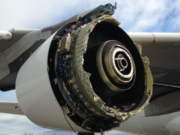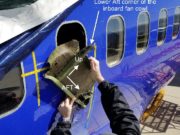The U.S. National Transportation Safety Board (NTSB) plans a public hearing in November on the uncontained engine failure that killed one passenger on a Southwest Airlines Boeing 737.
The NTSB said Tuesday that the Nov. 14 hearing on the April 17, 2018, accident on Southwest Flight 1380 will focus on three things:
- The design and development history of the CFM International CFM56-7 series engine fan blade;
- Inspection methods and procedures for the CFM International CFM56-7 series engine fan blade; and,
- Engine fan blade containment design and certification criteria.
“The hearing will be an important part of determining why this tragedy occurred and will provide investigators important factual data regarding the engine fan blade and engine inlet design and certification,” said John DeLisi, director of the NTSB Office of Aviation Safety.
The accident followed the failure of a fan blade, which caused fragments of the engine cowling and engine inlet to strike the fuselage, resulting in the loss of a passenger window and a rapid depressurization. The crew diverted to Philadelphia for an emergency landing. One of the 144 passengers was killed and eight passengers suffered minor injuries.
DeLisi noted that the April accident was the first fatal accident in nearly 10 years involving a Federal Aviation Regulations Part 121 passenger airliner. The last such accident was the Feb. 12, 2009, crash of a Colgan Air Bombardier DHC-8-40 on approach to Buffalo Niagara International Airport in New York. That crash killed all 49 people in the airplane and one person on the ground.
The NTSB said the probable cause of the Colgan accident was the captain’s “inappropriate response to the activation of the stick shaker, which led to an aerodynamic stall from which the airplane did not recover.”

